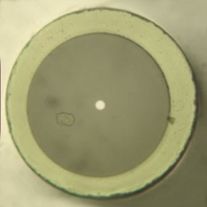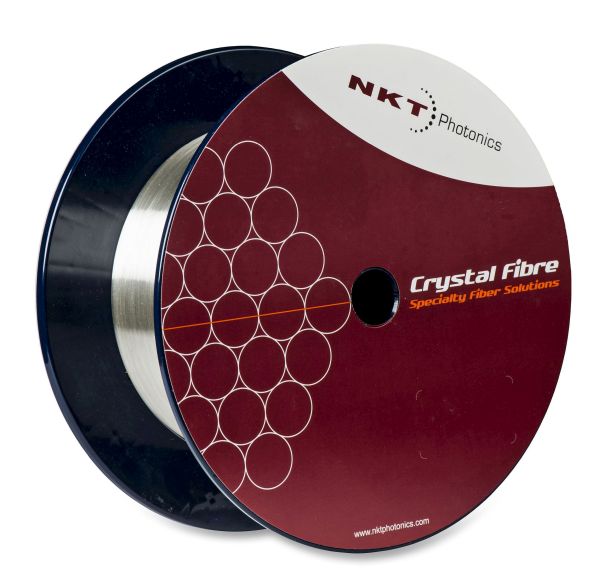cut-off wavelength (original) (raw)
Definition: a wavelength above which a guided mode of a waveguide ceases to exist
Alternative terms: cutoff wavelength, single-mode cutoff
Category:  fiber optics and waveguides
fiber optics and waveguides
- fiber properties
- acceptance angle
- bend losses
- cut-off wavelength
- differential mode delay
- effective mode area
- effective refractive index
- group velocity dispersion
- intermodal dispersion
- modal bandwidth
- mode radius
- polarization beat length
- propagation constant
- propagation losses
- V-number
- waveguide dispersion
- zero dispersion wavelength
- (more topics)
Related: wavelengthwaveguidesfibersmodesLP modesbend losses
Units: m
Formula symbol: ($\lambda_\textrm{co}$)
Page views in 12 months: 2866
DOI: 10.61835/ow7 Cite the article: BibTex BibLaTex plain textHTML Link to this page! LinkedIn
Content quality and neutrality are maintained according to our editorial policy.
📦 For purchasing single-mode fibers, use the RP Photonics Buyer's Guide — an expert-curated directory for finding all relevant suppliers, which also offers advanced purchasing assistance.
Contents
Definition of Cut-off Wavelength
The number of guided modes of a waveguide (for example, an optical fiber) depends on the optical wavelength: The shorter the wavelength, the more modes can be guided. For long wavelengths, there may be only a single guided mode (→ single-mode fibers) or even none at all, whereas multimode behavior is obtained at shorter wavelengths.
When a particular mode ceases to exist beyond a certain wavelength, that wavelength is called its cut-off wavelength. For an optical fiber, the cut-off wavelength for the LP11 mode sets a limit to the single-mode regime, as below that wavelength there is at least the LP01 and the LP11 mode.
Modes Close to Cut-off
Just below the cut-off wavelength, the mode properties often vary substantially. Typically, the mode radius (and thus the effective mode area) increases sharply near the cut-off, and the fraction of the optical power propagating within the waveguide core decreases accordingly. That effect is shown in Figure 1 for a multimode step-index fiber; similar behavior occurs for fibers with other transverse refractive index profiles.

Figure 1: Fraction of the power of various guided modes (where the colors are related to the ($l$) indices of those) which is contained in the fiber core as a function of the wavelength. The thin vertical lines indicate the calculated cut-off wavelengths of the modes. The diagram has been produced with the software RP Fiber Power.
For LPlm modes of a fiber, only for ($l = 0$) the fraction of the power guided in the core goes to zero when approaching the cut-off. For modes with higher ($l$), the mode size stays finite there, although it may be reduced substantially.
The drastically increased mode size close to cut-off also generally leads to a strong sensitivity to bending (→ bend losses). Even for moderate bending of the fiber one may then obtain sharply increasing propagation losses.
When light from a tunable laser is injected into a fiber, and its wavelength is tuned across the single-mode cut-off, the observed intensity pattern at the fiber's output end shows a sharp transition: It is simply shaped in the single-mode regime, but shows a high sensitivity to the input wavelength and the launch conditions in the multimode regime.
Behavior of Single-mode Fibers at Long Wavelengths
In step-index fibers, there is theoretically no cut-off for the fundamental (LP01) mode, although propagation losses at long wavelengths may still be high, even making the fiber unusable. Even well before running into the spectral region with strong infrared absorption beyond 2 μm wavelength, a single-mode fiber may become unusable for guiding light essentially because long-wavelength light would have a mode size well beyond the fiber core, where the mode becomes very sensitive e.g. to microbending. Note, however, that in such situations there is not a well-defined mode cut-off, but rather one sees gradually rising propagation losses at longer wavelengths.
For other (not step-index) fiber designs, in particular for some photonic crystal fibers, there can also be a fundamental mode cut-off.
Fibers with non-radially symmetric designs (and strongly bent fibers) can have polarization-dependent cut-off wavelengths.
Simulations on Cut-off Wavelengths
Explore, for example, how mode properties change near a cut-off wavelength, or what influence the cut-off wavelength of a fiber has on the performance of a device. Only with a suitable simulator, you get complete insight and fully optimize performance. The RP Fiber Power software is an ideal tool for such work.
Frequently Asked Questions
What is a cut-off wavelength in an optical fiber?
A cut-off wavelength is the wavelength beyond which a specific guided mode in an optical fiber ceases to propagate. Shorter wavelengths allow for more guided modes, while longer wavelengths support fewer or none.
How is the single-mode regime of a fiber defined?
The single-mode regime is defined by the cut-off wavelength of the second-lowest order mode (LP11 in standard fibers). The fiber guides only a single mode for all wavelengths longer than this cut-off value.
What happens to a guided mode as the wavelength approaches its cut-off?
As the wavelength approaches a mode's cut-off, the mode field typically expands significantly, extending further into the cladding. This makes the mode highly sensitive to bend losses, which can increase sharply.
Does the fundamental mode of a fiber have a cut-off wavelength?
In standard step-index fibers, the fundamental (LP01) mode has no theoretical cut-off and can exist at any wavelength. However, some special designs, like certain photonic crystal fibers, can have a fundamental mode cut-off.
Why can a single-mode fiber have high losses at very long wavelengths?
At very long wavelengths, the fundamental mode becomes weakly guided, and its size increases substantially. This makes it extremely sensitive to microbending, leading to high propagation losses even without a theoretical cut-off.
Suppliers
Sponsored content: The RP Photonics Buyer's Guide contains 40 suppliers for single-mode fibers. Among them:
⚙ hardware
The single-mode (SM) range of fibers developed from Fibercore has been designed to perform in a wide range of challenging applications using wavelengths between 450 nm and 1650 nm.
⚙ hardware
Effective dispersion compensation is a key requirement for many applications involving ultrafast lasers and broadband optical signals. Cycle can offer a variety of dispersion compensating fibers to satisfy the needs of your application. Our products include:
- single-mode dispersion compensating fibers (SM-DCF) and
- polarization-maintaining dispersion compensating fibers (PM-DCF)
with different connector types and customized lengths. Please contact us for more information.
⚙ hardware
LVF offers a large range of fluoride single-mode optical fibers for mid-infrared applications:
- ZrF4 (fluorozirconate) single-mode fibers with transparency ranging from 0.3 to 4.5 µm (typical background loss: <10 dB/km)
- InF3 (fluoroindate) single-mode fibers with transparency ranging from 0.3 to 5.5 µm (typical background loss: <15 dB/km)
LVF fluoride multimode fibers are the most transparent fibers on the market in the mid-infrared 2–5 µm band.
⚙ hardware
Optical fibers are at the heart of everything we do. We embed as many functions as possible directly into the fibers to make systems based on our fibers simpler, cheaper, and more reliable.
⚙ hardware
Schäfter+Kirchhoff offers single-mode fiber cables with different cut-off wavelengths and measured values for the effective fiber NA. Special broadband fiber RGB with an operational wavelength range 400–680 nm are also available. For FC PC or FC APC type connectors amagnetic connectors completely made of titanium can be selected.
Questions and Comments from Users
Here you can submit questions and comments. As far as they get accepted by the author, they will appear above this paragraph together with the author’s answer. The author will decide on acceptance based on certain criteria. Essentially, the issue must be of sufficiently broad interest.
Please do not enter personal data here. (See also our privacy declaration.) If you wish to receive personal feedback or consultancy from the author, please contact him, e.g. via e-mail.
By submitting the information, you give your consent to the potential publication of your inputs on our website according to our rules. (If you later retract your consent, we will delete those inputs.) As your inputs are first reviewed by the author, they may be published with some delay.










